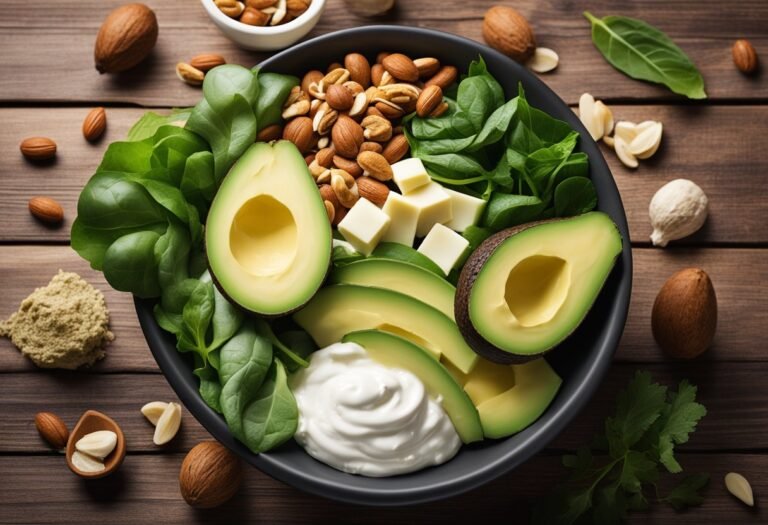Are Turnip Greens Keto Friendly? A Look at Their Carb Content
Are you following a keto diet and wondering if turnip greens are a good choice for you? Turnip greens are leafy green vegetables that can be cooked in various ways, such as sautéed, boiled, or steamed. They are known for their slightly bitter taste and are a popular ingredient in Southern cuisine. But are turnip greens keto-friendly?

To answer this question, we need to understand the basics of the keto diet. The keto diet is a low-carb, high-fat diet that aims to put your body in a state of ketosis, where it burns fat for fuel instead of carbohydrates. To achieve this, you need to limit your carb intake to around 20-50 grams per day. This means that you need to choose your foods wisely and opt for those that are low in carbs.
So, are turnip greens a good choice for a keto diet? The answer is yes! Turnip greens are low in carbs and high in fiber, making them an excellent choice for those following a keto diet. In this article, we will explore the nutritional profile of turnip greens, their health benefits, and how you can incorporate them into your keto diet.
Key Takeaways
- Turnip greens are a keto-friendly vegetable that is low in carbs and high in fiber.
- Incorporating turnip greens into your keto diet can provide numerous health benefits, such as improved digestion and lower inflammation.
- When cooking turnip greens, opt for healthy cooking methods such as sautéing or steaming to preserve their nutritional value.
Understanding Keto Diet Basics

Macronutrients in a Keto Diet
When you follow a keto diet, you need to pay attention to your macronutrient intake. The three macronutrients are carbohydrates, protein, and fat. In a keto diet, you will consume low amounts of carbohydrates, moderate amounts of protein, and high amounts of fat. This is because the goal of the keto diet is to get your body into a state of ketosis, where it burns fat for energy instead of carbohydrates.
To achieve this, you will need to restrict your carbohydrate intake to 20-50 grams per day. This means that you will need to avoid high-carbohydrate foods like bread, pasta, and sugary snacks. Instead, you will need to focus on foods that are high in healthy fats, such as avocados, nuts, and coconut oil.
Benefits of Ketosis
When you reach a state of ketosis, your body will start burning fat for energy instead of carbohydrates. This can lead to several benefits, including weight loss, improved energy levels, and better mental clarity. In addition, the keto diet is effective in improving certain health conditions, such as type 2 diabetes and epilepsy.
One of the main benefits of the keto diet is that it can help you lose weight. When you restrict your carbohydrate intake, your body will start burning fat for energy instead of carbohydrates. This can lead to rapid weight loss, especially in the first few weeks of the diet.
In addition to weight loss, the keto diet can also improve your energy levels. When your body is burning fat for energy, you will experience fewer energy crashes throughout the day. This can help you stay focused and productive, even during long workdays.
Overall, the keto diet can be an effective way to improve your health and achieve your weight loss goals. By following a diet that is high in healthy fats and low in carbohydrates, you can reach a state of ketosis and start burning fat for energy.
Nutritional Profile of Turnip Greens

Turnip greens are a keto-friendly vegetable with a low carbohydrate content and high fiber content. They are also a good source of vitamins and minerals, making them a nutritious addition to your diet.
Carbohydrate Content
Turnip greens are low in carbohydrates, with only 1.1 grams of net carbs per 100 grams of raw greens. This makes them a great choice for those following a keto diet, as they can be consumed in larger quantities without exceeding your daily carbohydrate limit.
Fiber and Net Carbs
Turnip greens are also high in fiber, with 3.2 grams of fiber per 100 grams of raw greens. This fiber content helps to reduce the net carbohydrate content of turnip greens, making them an excellent choice for those on a keto diet. The net carbohydrate content of turnip greens is only 1.1 grams per 100 grams of raw greens, making them an ideal choice for those looking to increase their fiber intake while staying within their daily carbohydrate limit.
In summary, turnip greens are a keto-friendly vegetable that can be consumed in larger quantities without exceeding your daily carbohydrate limit. They are also a good source of fiber, vitamins, and minerals, making them a nutritious addition to your diet.
Health Benefits of Turnip Greens

Turnip greens are not only keto-friendly but also incredibly nutritious. They are packed with essential vitamins, minerals, and antioxidants, offering a wide range of health benefits.
Vitamins and Minerals
Turnip greens are an excellent source of vitamins and minerals. They are particularly rich in vitamin K, which plays a role in blood clotting and may help reduce the risk of heart disease. One cup of cooked turnip greens provides over 500% of the daily recommended intake of vitamin K.
In addition to vitamin K, turnip greens are also a good source of vitamin A, vitamin C, calcium, and iron. Vitamin A is essential for maintaining healthy vision, while vitamin C plays a role in immune function and skin health. Calcium and iron are important for bone health and energy production, respectively.
Antioxidant Properties
Turnip greens are also rich in antioxidants, which help protect your cells from damage caused by free radicals. Free radicals are unstable molecules that can cause oxidative stress, leading to chronic inflammation and an increased risk of chronic diseases such as cancer, diabetes, and heart disease.
One of the antioxidants found in turnip greens is beta-carotene, which is converted into vitamin A in the body. Beta-carotene has been linked to a reduced risk of certain types of cancer, such as lung cancer.
Another antioxidant found in turnip greens is lutein, which is important for eye health. Lutein has been shown to reduce the risk of age-related macular degeneration, a leading cause of blindness in older adults.
Incorporating turnip greens into your keto diet can provide a variety of health benefits, from supporting heart health to protecting your cells from damage.
Incorporating Turnip Greens into a Keto Diet
If you’re looking to incorporate more leafy greens into your keto diet, turnip greens are a great option. Not only are they low in carbs, but they are also packed with essential vitamins, minerals, and antioxidants. Here are some tips for incorporating turnip greens into your keto diet:
Keto-Friendly Turnip Greens Recipes
Turnip greens can be enjoyed in a variety of ways on a keto diet. One simple recipe is to sauté them with olive oil and garlic for a flavorful side dish. You can also add turnip greens to soups or stews for a nutrient boost. For a low-carb salad, try mixing turnip greens with other keto-friendly vegetables like cucumber, avocado, and bell peppers.
Here’s a recipe for a delicious turnip greens and bacon salad:
Ingredients:
- 1 bunch of turnip greens
- 4 slices of bacon
- 1/4 cup of diced red onion
- 1/4 cup of crumbled feta cheese
- 1 tablespoon of olive oil
- 1 tablespoon of apple cider vinegar
- Salt and pepper to taste
Instructions:
- Wash and chop the turnip greens into bite-sized pieces.
- Cook the bacon in a skillet until crispy, then crumble it into small pieces.
- In a small bowl, whisk together the olive oil, apple cider vinegar, salt, and pepper.
- In a large mixing bowl, combine the turnip greens, bacon, red onion, and feta cheese.
- Drizzle the dressing over the salad and toss to combine.
Portion Control and Frequency
While turnip greens are a healthy addition to a keto diet, it’s important to practice portion control and not overdo it. Aim to include a serving of turnip greens in your meals a few times a week, rather than every day. One serving of turnip greens is about 1 cup raw or 1/2 cup cooked. Keep in mind that turnip greens are high in oxalates, which can interfere with calcium absorption, so it’s best to consume them in moderation.
Possible Concerns and Considerations
Oxalates in Greens
One concern when consuming turnip greens is their oxalate content. Oxalates are naturally occurring compounds found in many foods, including leafy greens like turnip greens. High levels of oxalates can lead to the formation of kidney stones in some individuals. However, the risk of kidney stones from consuming oxalates is relatively low for most people, especially if you stay hydrated.
If you are concerned about oxalates, you can try blanching the turnip greens before consuming them. Blanching can help reduce the oxalate content in the greens. Additionally, you should avoid consuming large amounts of high-oxalate foods, such as spinach, rhubarb, and almonds, if you are at risk of kidney stones.
Interactions with Medication
If you are taking medication, it is important to be aware of any potential interactions with turnip greens. Turnip greens contain vitamin K, which can interfere with blood-thinning medications like warfarin. If you are taking blood-thinning medication, it is important to speak with your healthcare provider about the appropriate intake of vitamin K-rich foods like turnip greens.
Furthermore, turnip greens contain goitrogens, which are compounds that can interfere with the function of the thyroid gland. If you have an underactive thyroid or are taking medication for thyroid issues, it is important to speak with your healthcare provider before consuming large amounts of turnip greens.
Overall, turnip greens can be a healthy addition to a keto diet, but it is important to be aware of any potential concerns or interactions with medication. By being mindful of your intake and speaking with your healthcare provider, you can safely incorporate turnip greens into your keto meal plan.
FAQs About Are Turnip Greens Keto Friendly?
How many carbs are in a cup of cooked turnip greens?
One cup of cooked turnip greens contains only about 4 grams of carbs, with nearly 3 grams coming from fiber. This means that the net carb count for turnip greens is very low, making them an excellent choice for those following a ketogenic diet.
What greens are recommended for a keto diet?
Leafy greens such as spinach, kale, and collard greens are excellent choices for a keto diet. They are low in carbs and high in nutrients, making them a great addition to any meal.
Can diabetics include turnip greens in a keto diet?
Yes, turnip greens can be a good choice for diabetics on a keto diet. They are low in carbs and high in fiber, which can help regulate blood sugar levels.
Are there keto-friendly recipes that include turnip root?
Yes, many keto-friendly recipes include turnip root. Some popular options include turnip fries, turnip gratin, and turnip mash.
What vegetables should be avoided on a keto diet?
Vegetables that are high in carbs should be avoided on a keto diet. This includes starchy vegetables like potatoes, sweet potatoes, and corn. Other vegetables like carrots and beets should also be limited.
Can turnip greens be eaten for breakfast on a keto diet?
Yes, turnip greens can be eaten for breakfast on a keto diet. They can be added to omelets or scrambled eggs, or sautéed with bacon for a delicious and nutritious breakfast.






